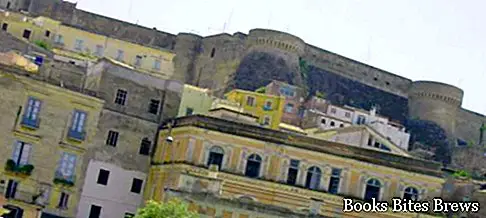What to see in Gaeta, itinerary including the main monuments and places of interest, including the Golden Chapel, Castle, Montagna Spaccata and the Cathedral of Saints Erasmus and Marciano.
Tourist information
Gaeta, a town in the province of Latina, in Lazio, is a renowned tourist and seaside resort, which boasts a remarkable historical, artistic and naturalistic heritage.
The town is located on the promontory of Monte Orlando, 163 meters above sea level, which represents the extension towards the sea of the Aurunci mountains.
The promontory, covered with a rich Mediterranean scrub, ends with a scenic cliff overlooking the sea in the large Gulf of Gaeta.
The limestone rock of the promontory has spectacular cracks, in particular the three slits of the place known as Montagna Spaccata and the Grotta del Turco, very beautiful to visit.
The historic center of Gaeta is formed by the oldest part, corresponding to the medieval quarter of Sant'Erasmo located at the eastern end of the promontory, from the ancient village of Porto Salvo, built outside the walls since the eighth century along the coast in direction of Formia, and from the more recent urban part, which is located on the sandy isthmus of Montesecco and which represents the connection between Mount Orlando and the mainland.
Since the Roman Empire, the territory of Gaeta has been a holiday resort for emperors and important personalities, as evidenced by the imposing Mausoleum of the Roman consul Lucio Munazio Planco, known as Torre d'Orlando, which looks at the sea from the top of the Promontory.
Due to the high and defensible position of the promontory, Gaeta became a castrum towards the eighth century, although the first news on the existence of the Castle dates back to 1223 when Frederick II of Swabia fortified the existing fortress.
What see
The current Angioino-Aragonese Castle, which dominates the entire medieval center, is made up of two communicating buildings dating back to two different periods, the lower one, called Angioino, was built during the French domination by the Angevins, while the structure more high, called Aragonese, was built on commission by the emperor Charles V, together with all the other military defense works that contributed to strengthening the defensive structure of Gaeta, used for a long time as a military garrison, as evidenced by the remains of fortifications and tunnels dug in the mountain dating back to the time of the Bourbons.
In the dome of the highest tower of the castle is the Royal Chapel, built in 1849 by the will of King Ferdinand of Bourbon.
Inside the medieval quarter, near the port, stands the Cathedral of Saints Erasmus and Marciano, featuring a beautiful bell tower in the Arab-Moorish style.
Recommended readings- Anagni (Lazio): what to see
- Lazio: Sunday day trips
- Vetralla (Lazio): what to see
- Ciociaria (Lazio): what to see in the historic region
- Alatri (Lazio): what to see
The Duomo was built around the year 1000 on the previous church of Santa Maria del Parco, probably dating back to the seventh century, and was consecrated by Pope Pasquale II in 1106.
Originally in Romanesque style, the building has undergone numerous transformations over the centuries.
Near the Cathedral is the Diocesan Museum, which houses, among other things, the Banner of the Battle of Lepanto, which was hoisted in 1571 on the flagship of the papal fleet during the famous Battle of Lepanto between the Christian fleet, led by Don Giovanni of Austria, and the ships of the Turks.
Gaeta has a rich patrimony of churches, among these we point out the beautiful Church of the Santissima Annunziata, a seventeenth-century reconstruction of a church dating back to the fourteenth century.
Attached to the Church is the famous Chapel of the Immaculate Conception, known as the Golden Chapel or Golden Grotto, which owes its name to the coffered ceiling made of wood and beautifully decorated with pure gold finishes.
In this chapel, Pope Pius IX used to gather in prayer, in the period when, exiled from Rome, he took refuge in Gaeta because of the well-known Risorgimento events,
It was in this place that the pontiff had the inspiration for the drafting of the Dogma of the Immaculate Conception, an event dating back to 1854.
Every year in Gaeta, on the second Sunday of August, the Madonna di Porto Salvo, patron saint of seafarers, is celebrated.
The party takes place with a procession of decorated and flag-shaped boats at sea, which follow the main boat where the statue of the Madonna is located.
The procession reaches Punta Stendardo, where a crown is thrown into the water to commemorate the fallen of the sea.




